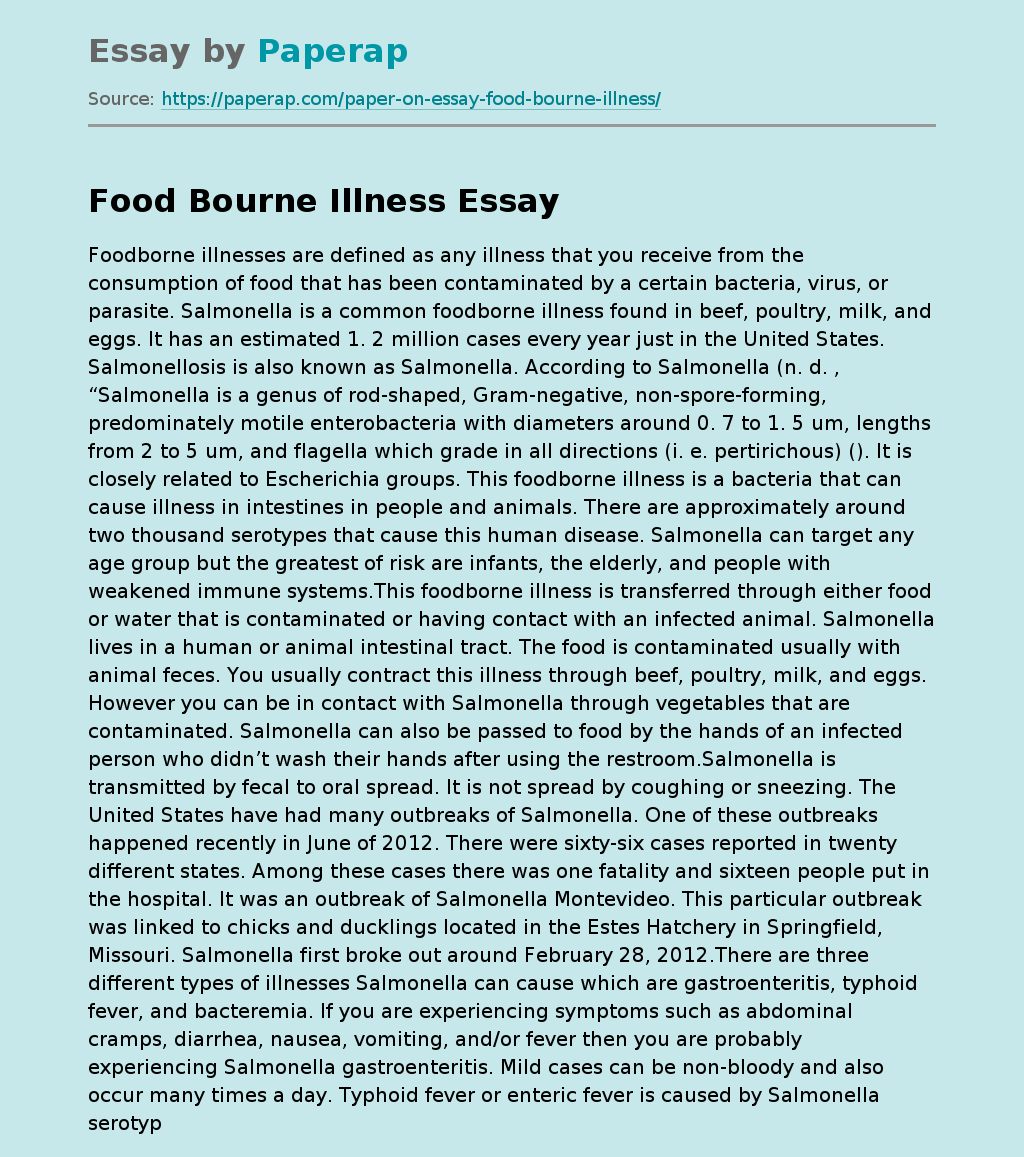Food Bourne Illness
Foodborne illnesses are defined as any illness that you receive from the consumption of food that has been contaminated by a certain bacteria, virus, or parasite. Salmonella is a common foodborne illness found in beef, poultry, milk, and eggs. It has an estimated 1. 2 million cases every year just in the United States. Salmonellosis is also known as Salmonella. According to Salmonella (n. d. , “Salmonella is a genus of rod-shaped, Gram-negative, non-spore-forming, predominately motile enterobacteria with diameters around 0. 7 to 1. 5 um, lengths from 2 to 5 um, and flagella which grade in all directions (i.
e. pertirichous) (). It is closely related to Escherichia groups. This foodborne illness is a bacteria that can cause illness in intestines in people and animals. There are approximately around two thousand serotypes that cause this human disease. Salmonella can target any age group but the greatest of risk are infants, the elderly, and people with weakened immune systems.This foodborne illness is transferred through either food or water that is contaminated or having contact with an infected animal.
Salmonella lives in a human or animal intestinal tract. The food is contaminated usually with animal feces.
You usually contract this illness through beef, poultry, milk, and eggs. However you can be in contact with Salmonella through vegetables that are contaminated. Salmonella can also be passed to food by the hands of an infected person who didn’t wash their hands after using the restroom.Salmonella is transmitted by fecal to oral spread. It is not spread by coughing or sneezing. The United States have had many outbreaks of Salmonella.
One of these outbreaks happened recently in June of 2012. There were sixty-six cases reported in twenty different states. Among these cases there was one fatality and sixteen people put in the hospital. It was an outbreak of Salmonella Montevideo. This particular outbreak was linked to chicks and ducklings located in the Estes Hatchery in Springfield, Missouri. Salmonella first broke out around February 28, 2012.There are three different types of illnesses Salmonella can cause which are gastroenteritis, typhoid fever, and bacteremia. If you are experiencing symptoms such as abdominal cramps, diarrhea, nausea, vomiting, and/or fever then you are probably experiencing Salmonella gastroenteritis. Mild cases can be non-bloody and also occur many times a day. Typhoid fever or enteric fever is caused by Salmonella serotype typhi. You notice these symptoms about five to twenty one days after ingestion of bacteria. The symptoms include cough, sore throat, headache, constipation, and a rash on your chest.Slowing of your heartbeat and enlargement of the liver and spleen may also occur.
Bacteremia is infection of tissues that surround the brain and spinal cord also known as meningitis and infection in the bloodstream known as sepsis. According to Outbreak, Inc. (2005-2012) “Salmonella enter and circulate within an infected individual’s bloodstream, and is accompanied by few symptoms” (Complications of Salmonella Infection). Symptoms become noticeable in about twelve to thirty six hours and last about three to ten days for Salmonella.Many things can be done to prevent getting Salmonella. You should always cook your poultry, meats, and eggs all the way through. The heat actually kills the Salmonella bacteria. Be careful handling uncooked meat and make sure not to cross contaminate and always wash your hands after being in contact with raw meat. Meat, poultry, eggs, and anything that contains these products should always be kept refrigerated. Make sure you avoid drinking any water out of a stream, lake, ocean, etc. According to Communicable Disease Epidemiology Program (n. . ), “Don’t drink raw milk, or eat unpasteurized diary products” (How can you keep from getting it? ). Always wash your hands after changing a babies bottom is another precaution to take.
Avoid any animal droppings and wash your hands after handling animals. In conclusion Salmonella is a foodborne illness having to do with meats, poultry, raw eggs, and milk which can be prevented by washing your hands thoroughly and keep from cross contamination. You should look for your symptoms early and expect them to last a few days at the least.References Centers for Disease Control and Prevention. (n. d. ) Salmonella. Retrieved from Centers for Disease Control Prevention. (n. d. ). Salmonella. Retrieved from Clark, M. (2005-2012). How to prevent a Salmonella infection. Retrieved from http://www. about-salmonella. com/salmonella prevention/ Communicable Disease Epidemiology Program. (n. d. ). Salmonella. Retrieved from http://www. cdphe. state. co. s. dc. epidemiology/salm fs. html Oberg, Valle. (2011, August). Eleven steps to prevent salmonella. Street Articles (). Outbreak, Inc. (2005-2012). Symptoms of Salmonella infection. Retrieved from Salmonella prevention. (n. d. ) Retrieved from Retrieved from Salmonella. (n. d. ). Retrieved from
Food Bourne Illness. (2019, Dec 05). Retrieved from https://paperap.com/paper-on-essay-food-bourne-illness/

